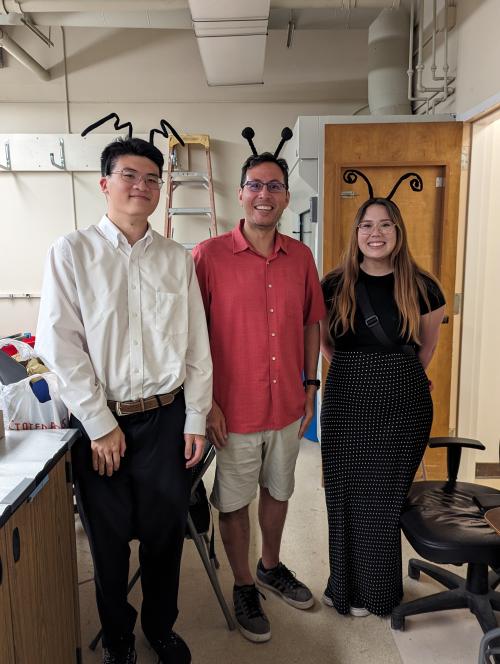
Undergraduates Design Experiments Around Real-World Questions
Matthew Sutfin’s interest in aviation started around 10-years-old. By age 17, he was flying aircraft, taking to the sky to get a bird’s eye view of the world. Such a vantage can help one make sense of things. For Sutfin, chemistry also does this.
“Chemistry, in my mind, helps me interpret the way the world works around me,” he said.
Perhaps no course cements this idea more than "CHE 125 — Advanced Methods in Physical Chemistry." In the course, undergraduate students apply advanced theory and laboratory techniques to personal research projects that they complete in a 10-week time frame. They conduct experiments, analyses, compile a final research report and then present their work. The idea is to give undergraduate students a taste of the research world and laboratory life.
“Giving the students complete autonomy over their projects develops into vital skills like project management and coordination,” said Javier Aztiazarain, a graduate student in the Department of Chemistry and CHE 125’s teaching assistant. “Students learn to get over their fears of presenting by uniting together. Ultimately, we want them to brazenly embrace their projects and personalize them not only for entertainment, but educational purposes as well.”
Not only do the students design their research projects, but they also harness the advanced, leading-edge tools of the Chemistry Annex Instrumentation Lab, where they can analyze molecular compounds at incredibly fine levels.
“A secondary goal is to ensure the students have advanced training on an analytical instrument of their choice — gaining confidence during job interviews or exploring additional research opportunities,” Aztiazarain said.

Analyzing leaded aviation fuels
For their project, Sutfin and his research colleague Sophia Bessa, who both graduated in 2024 with degrees in chemistry, decided to examine the presence of environmental lead in the soil around University Airport located in Davis.
“For small, piston-engine aircraft, aviation fuel is still leaded, which I didn’t know before working on this project,” Bessa said. “So we were really trying to understand the pathway of how lead pollution begins: how the fuel is combusted, and how it enters the atmosphere and environment through the exhaust.”
To better understand the lead pollution pipeline, Bessa and Sutfin analyzed piston-engine aviation fuel, collected soot from the exhaust pipe of Cessna airplanes and sampled soil from the launching area at the University Airport. They then used gas chromatography-mass spectrometry to confirm the presence of lead in the fuel and performed flame atomic absorption spectroscopy for environmental and emissions analyses.

“I was honestly a little concerned,” Bessa said. “You’re at an airport and you would think the levels would be extremely high. What we did notice about some of the soil samples was that the lead was elevated compared to unpolluted soil, but it wasn’t at a threshold that’s considered dangerous by the Environmental Protection Agency (EPA).”
Even unpolluted soils contain lead, on average ranging from 15-40 parts per million. The EPA recommends that total lead levels in soil not equate to or exceed 400 parts per million. Lead levels in Bessa’s and Sutfin’s soil samples were between 11 and 140 parts per million, depending on the area tested.
Despite finding the presence of lead in the soil around University Airport, the team couldn’t determine how much the aircraft contributed to soil lead levels.
“We had to really simplify the project because there were just so many variables,” Sutfin said. “But I think that was kind of one of the nice parts about taking CHE 125…We could dive into a problem and then kind of unveil the layers of the onion and start seeing how complex it is to come out with a definitive answer”
Aztiazarain said that projects with unanswered questions can be picked up by future CHE 125 students. “This is an angle we mention in the class during examples of projects attempted,” he said.

Pesticides in honey
First-generation college student Kela Serafino had never worked in a lab. While taking "CHE 115 — Instrumental Analysis," she met Aztiazarain and expressed interest in lab work. Thanks to the connection, Serafino started learning more about wet lab chemistry and audited CHE 125.
“When I saw all the different student projects, it really excited me and I learned what’s expected,” Serafino said. “It motivated me to pursue taking the class.”
Serafino, who graduated in 2024 with a degree in chemistry, and her research partner Liam Wong, who graduated in 2024 with degrees in chemistry and Japanese, analyzed the presence of the insecticide imidacloprid in honey.

“It’s chemically similar to nicotine,” Serafino explained. “With the collapse of honeybee populations and their critical role as pollinators, we thought it was important to analyze the presence of this insecticide in honey.”
Serafino and Wong intended to partner with a local apiary to analyze their honey samples. But, as is the case with many research projects, the team pivoted when honey samples couldn’t be acquired in time for the experiment.
Instead, the team turned to commercially available honey on Amazon. They then used solid-phase extraction methods and liquid chromatography-mass spectrometry to analyze the samples.
“The first thing that was surprising to me is that we actually were able to detect the insecticide we were looking for but in really low quantities,” said Wong, noting that the team had to really refine their protocols to ensure such fine detection. “It was exciting to see that all of our time spent on method development allowed us to achieve such results.”
The team detected 0.1 to 0.6 nanograms per gram of imidacloprid in their honey samples. While those levels aren’t necessarily harmful to humans, they could be harmful to honeybees. Previous research indicates that honeybee mortality increased by 50% at imidacloprid levels of 0.1 nanogram per bee.
“Honeybees are incredible insects, but they are also a crucial part of our ecosystem,” Serafino said. “Pesticides can be a major detriment to these pollinators’ livelihood and it is a necessity to keep them healthy and happy.”
Applying lessons to the real world
Wong said he’s often heard Aztiazarain and other teaching assistants describe CHE 125 as similar to graduate school. The students balance a myriad of responsibilities: coursework from other classes, jobs outside of the lab and then the lab project itself.
“Mentors in the class, like Javier, have said that it’s a window into grad life,” Wong said. “It’s kind of that first foray into what a real industry job or grad school would be like.”
For Bessa, who now works in an analytical chemistry lab at Driscoll’s, the lessons she learned in CHE 125 are paying dividends in her professional life.
“Two of the biggest skills that you can glean from studying analytical chemistry are creativity and problem-solving,” she said. “Learning to work with what’s in front of you and making the most of it is probably one of the biggest skills that I’ve taken away from the course and applied here.”
“You can always make the most of something,” she added. “You might not necessarily end up where you intended but there’s always something to be learned.”
